Product videos, user content, and customer service options are among the features that leading online retailers are using to differentiate product detail pages and, possibly, boost sales.
Good product detail pages will almost certainly include high-quality images, a qualitative product description, a list of specifications, a price, and a call to action. These characteristics, if you will, are the requirements for success.
Above and beyond these essentials, many leading online retailers are adding features, content, and offerings to help build trust and boost conversions. What follows are seven examples of differentiating content that you can add to your site.
1. Video
In March, iVentures Consulting, a management and digital-business consultancy, released the results of its most recent eShopper Index, which examines 111 online retailers and the customer experience those retailers provide.
The report found that 32 percent of the retailers reviewed now include some form of video — product demonstration video, a how-to use video, or even tips and suggestion videos.
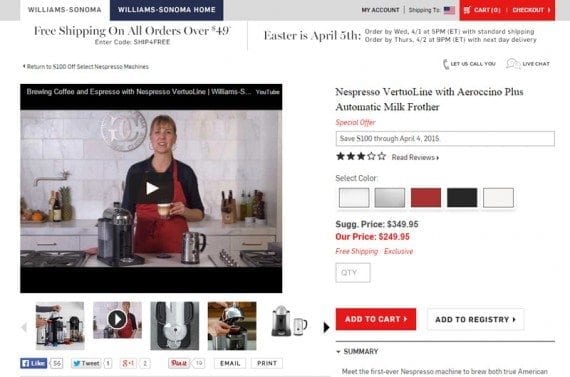
Williams-Sonoma includes product videos on many of its product detail pages.
These embedded videos may give shoppers easy-to-understand information about the product, which may lead to increased sales. In fact, in January 2015, Marketing Land reported the results of a study suggesting that product videos boost ecommerce conversion rates 9 percent.
2. Multiple Images of Each Product
High-quality product images are a must have on your product detail page. In fact, iVentures found that 97 percent of the retailers they reviewed include a great product shot on product pages. But there may be an opportunity to add more product images, since only 52 percent of the retailers examined included multiple product pictures.
The idea is that the extra pictures will give shoppers a better feeling for the product and, possibly, encourage the sale.

Saks Fifth Avenue uses several product images (and videos) on its product detail pages.
3. Customer-submitted Product Images
Some retailers are also asking customers to provide product images. The best of the customer-submitted images can go directly on product detail pages.
Retailers will sometimes separate these customer images in a special section. ThinkGeek, the specialty retailer, does this on the bottom of many of its product detail pages. Other retailers will integrate good customer shots inline with “professional” product images.

ThinkGeek has a section at the bottom of some of its product detail pages for customer-submitted product photos.
4. Customer Review and Ratings
For several years various studies have reported, even ballyhooed, the value of including customer reviews and ratings on ecommerce product detail pages.
Back in 2012, Shopify reported that studies show results from a 14-percent boost in sales to a 76-percent increase when reviews were added. More recently, iSenseLabs cited a study from MarketingProfs showing that, perhaps, 70 percent of shoppers will read reviews when they are available.
Yet, according to the iVentures findings, only 55 percent of the online sellers reviewed offer customer reviews and only 52 percent included a customer-driven rating system. Thus, reviews and ratings could be a differentiator for your store.
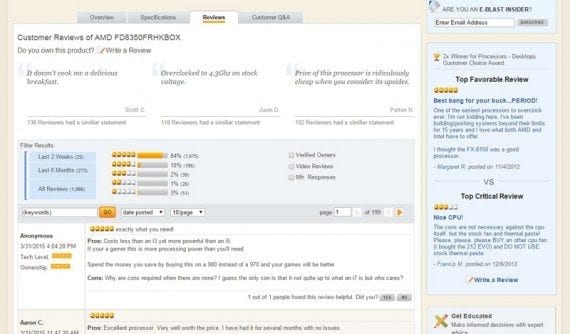
It is common for a Newegg product detail pages to include thousands of product reviews.
5. Return Policy Information
Ecommerce is not new. Folks have been shopping online for more than a decade. Nonetheless, it is still important to reassure shoppers. They won’t buy from your store if they don’t trust your store.
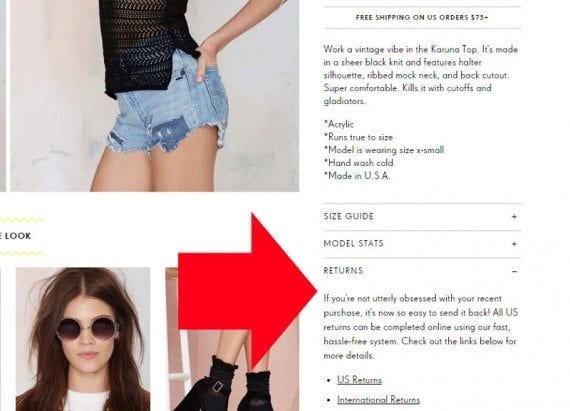
Nasty Gal includes its return policy information on its product detail pages.
Having a liberal and open return policy and proudly showing that policy on product detail pages may be one way of helping to build trust. As such, some online sellers have started to add a returns or shipping and returns sections to product pages. Here are a few examples, in no particular order.
6. Shipping Information
A close cousin to return policies is shipping information. For some time, retailers have included banners and similar shipping or free shipping promotions on product detail pages. But now, some are starting to include additional shipping information and details, such as expected arrival dates.
This additional shipping information may encourage some shoppers to make a purchase or even upgrade from a free service to a paid service.
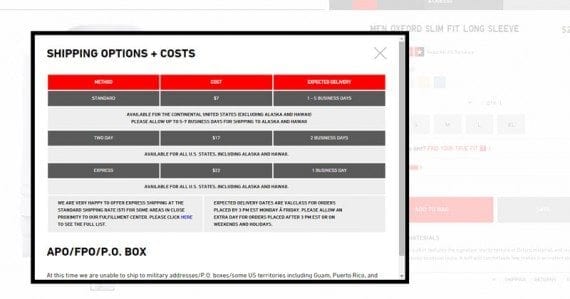
Uniqlo makes it easy to get shipping information.
In practice, some retailers, such as Uniqlo, include a shipping link that opens a modal window with all of the pertinent shipping information. Others sellers, like The Home Depot, include the shipping data right next to the product price.
7. Customer Service Options
The iVentures review found that 39 percent of the subject retailers include customer service information directly on product detail pages, often posting an option to email, call, or chat for help.
A good example of this can be seen on the Suitsupply website. The company has a link in the footer for service, an icon and link — offering telephone and email support and a chat window for immediate help.
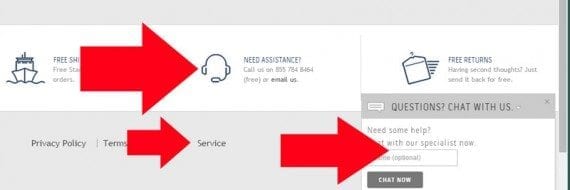
Suitsupply includes customer service options on its product detail pages.
Offering shoppers a way to get customer service help directly from a product detail page may have two effects on sales.
First, like including return policy information, including customer service options on a product detail page may help some shoppers feel more comfortable making a purchase from your store.
Second, if chat is available, a customer service representative may be able to answer questions or alleviate concerns and, ultimately, make a sale that would not have happened otherwise.
In either case, offering customer service options right where the customer is shopping could be a product page differentiator.



